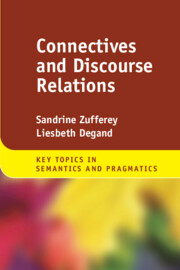Book contents
- Connectives and Discourse Relations
- Key Topics in Semantics and Pragmatics
- Connectives and Discourse Relations
- Copyright page
- Contents
- Figures
- Tables
- 1 Defining Connectives and Discourse Relations
- 2 Theoretical Models of Discourse Relations
- 3 Connectives: Meanings and Functions
- 4 Connectives between Syntax and Discourse
- 5 The Evolution of Connectives’ Meanings
- 6 Processing and Understanding Discourse Relations and Connectives
- 7 Discourse Relations and Connectives across Languages and Genres
- 8 Acquiring Connectives in a First Language
- 9 Mastering Connectives in a Second Language
- Conclusion
- Glossary
- References
- Index
- References
References
Published online by Cambridge University Press: 22 February 2024
- Connectives and Discourse Relations
- Key Topics in Semantics and Pragmatics
- Connectives and Discourse Relations
- Copyright page
- Contents
- Figures
- Tables
- 1 Defining Connectives and Discourse Relations
- 2 Theoretical Models of Discourse Relations
- 3 Connectives: Meanings and Functions
- 4 Connectives between Syntax and Discourse
- 5 The Evolution of Connectives’ Meanings
- 6 Processing and Understanding Discourse Relations and Connectives
- 7 Discourse Relations and Connectives across Languages and Genres
- 8 Acquiring Connectives in a First Language
- 9 Mastering Connectives in a Second Language
- Conclusion
- Glossary
- References
- Index
- References
Information
- Type
- Chapter
- Information
- Connectives and Discourse Relations , pp. 218 - 251Publisher: Cambridge University PressPrint publication year: 2024
- Creative Commons
- This content is Open Access and distributed under the terms of the Creative Commons Attribution licence CC-BY-NC-ND 4.0 https://creativecommons.org/cclicenses/
